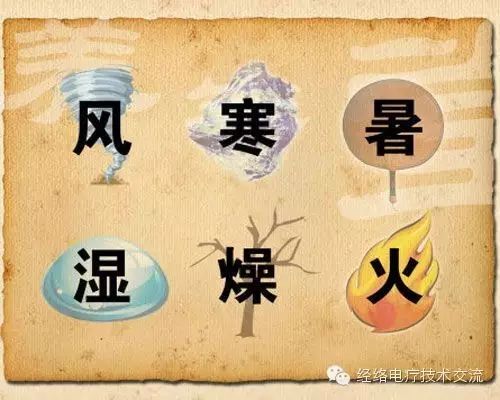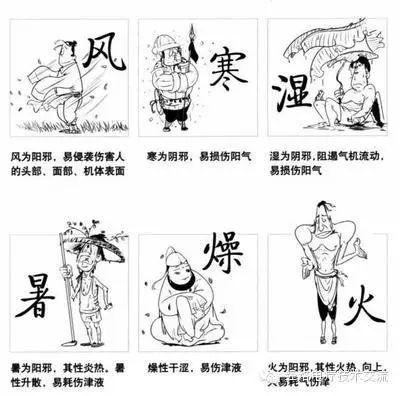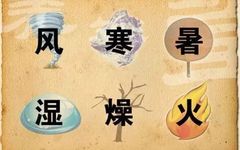External pathogenic factors refer to those that invade the body from the outside, either through the skin and hair or through the mouth and nose, causing external diseases. External diseases are a category of illnesses caused by these external pathogenic factors, typically presenting acutely with symptoms such as chills and fever, sore throat, and joint pain. External pathogenic factors can be broadly classified into two categories: the Six Excesses (Liù Yín) and Epidemics (Yì Lì).
 Six Excesses
Six Excesses
The so-called Six Excesses are a collective term for the six external pathogenic evils: Wind (Fēng), Cold (Hán), Summer Heat (Shǔ), Dampness (Shī), Dryness (Zào), and Fire (Huǒ).
Characteristics and pathogenic features of the Six Excesses:
1. Wind
The nature and pathogenic characteristics of Wind: Wind is light and mobile, easily changing and shifting. When Wind prevails, it causes movement, which is a fundamental characteristic of Wind.
① Light and dispersive: Wind is a Yang evil, characterized by its lightness and ability to rise and disperse. Therefore, Wind tends to harm the upper body and invade the muscle surface and lower back, which are Yang areas.
② Easily changes and moves: Wind is characterized by its ability to move and not remain in one place. This means that diseases caused by Wind often have shifting locations and unpredictable symptoms.
③ Active nature of Wind: The active nature of Wind refers to its tendency to cause instability in the body. Symptoms may include dizziness, tremors, convulsions, and other signs of movement, hence the saying “when Wind prevails, movement occurs.”
④ Wind as the leader of all diseases: Wind is often the precursor to other evils such as Cold, Dampness, Dryness, and Heat, which tend to attach themselves to Wind to invade the body. For example, it combines with Cold to form Wind-Cold, with Heat to form Wind-Heat, with Dampness to form Wind-Dampness, and so on.
2. Cold
The nature and pathogenic characteristics of Cold: Cold is characterized by its coldness, stagnation, and constriction.
① Cold easily harms Yang: Cold is a manifestation of Yin energy, thus it is considered a Yin evil. While Yang energy can counteract Yin, an excess of Yin can lead to a deficiency of Yang, resulting in the saying “when Yin prevails, Cold prevails” and “when Yin prevails, Yang becomes ill.”
② Cold causes stagnation: Stagnation refers to the blockage of Qi and blood flow. The movement of Qi, blood, and body fluids relies on the warmth of Yang energy. When Cold invades the body, it can cause Qi and blood to stagnate, leading to pain, which is a significant characteristic of Cold-related diseases.
③ Cold causes constriction: Constriction refers to the tightening and pulling nature of Cold. Cold can cause the Qi to contract, leading to blockages in the meridians and joints, resulting in pain and limited movement.
3. Summer Heat
The nature and pathogenic characteristics of Summer Heat: Summer Heat is a transformation of Fire, primarily characterized by its ability to rise and disperse, often accompanied by Dampness.
① Summer Heat is hot: Summer Heat is associated with the intense heat of summer, characterized by high temperatures and Yang energy. Symptoms include high fever, irritability, and a rapid pulse, known as Summer Heat injury.
② Summer Heat rises and disperses: Summer Heat tends to invade the head and disturb the mind, leading to symptoms such as excessive sweating.
③ Summer Heat often carries Dampness: The summer season is not only hot but also often rainy and humid, leading to a combination of heat and humidity in the environment.

4. Dampness
The nature and pathogenic characteristics of Dampness: Dampness is a Yin evil that obstructs the flow of Qi and easily harms Yang energy, characterized by its heaviness and stickiness.
① Dampness is a Yin evil that obstructs Qi and damages Yang: Dampness is similar to water, which is Yin in nature. When Dampness invades the body, it can obstruct the flow of Qi, leading to symptoms such as chest tightness and digestive issues.
② Dampness is heavy and turbid: Dampness is characterized by its heaviness, leading to symptoms such as a heavy head and limbs.
③ Dampness is sticky: Dampness can cause symptoms that are sticky and uncomfortable, such as sticky stools and a coated tongue.
④ Dampness tends to descend: Being similar to water, Dampness tends to affect the lower parts of the body.
5. Dryness
The nature and pathogenic characteristics of Dryness: Excessive Dryness can lead to damage, particularly to the lungs.
① Dryness injures body fluids: Dryness arises when humidity decreases, leading to symptoms of dryness and depletion.
② Dryness easily harms the lungs: The lungs prefer moist environments and are easily harmed by Dryness.
6. Fire
The nature and pathogenic characteristics of Fire: Fire is characterized by burning, inflammation, and the consumption of Qi and body fluids.
① Fire burns: Fire is characterized by its ability to burn and scorch, leading to symptoms of high fever and rapid pulse.
② Fire causes inflammation: Fire tends to rise and can lead to symptoms in the upper body, such as a red and painful tongue.
③ Fire consumes body fluids: Fire can lead to dehydration and symptoms such as thirst and dry mouth.
④ Fire can cause internal wind and blood movement: Fire can lead to disturbances in the liver and blood flow, causing various symptoms.
⑤ Fire can lead to swelling and sores: Fire can lead to localized infections and inflammation.
⑥ Fire can disturb the mind: Fire can lead to symptoms of anxiety and insomnia.
Long press the QR code below to follow me~


Visit our store for more insights.

